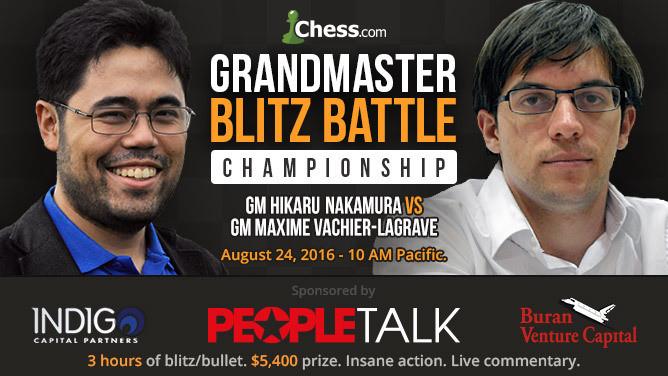
Nakamura Routs MVL Via 3-Minute Special, Will Face Carlsen In Blitz Battle Final
For those expecting GM Hikaru Nakamura to beat GM Maxime Vachier-Lagrave by dominating the bullet segment, you were half right. He won, but it was over by the time they reached the one-minute.
THE CARLSEN-NAKAMURA FINAL WILL BE PLAYED 27 OCTOBER 2016! MORE INFO HERE.
The Chess.com Grandmaster Blitz Battle Championship's number-two seed annihilated the three seed by doing the near-impossible. He went undefeated, but in the three-minute portion. Nakamura won the middle block 8.5-1.5 en route to a 21.5-10.5 overall drubbing.
"I couldn't play a proper game," Vachier-Lagrave said. "The losses started piling one on another and I just couldn't control the match...I was thoroughly dominated."
From game seven to 24, Nakamura went +11 =6 -1.

While GM Magnus Carlsen was able to "double up" GM Alexander Grischuk in the other semifinal yesterday (16-8), Nakamura did even better by scoring more than double his opponent today.
Today's duo also shattered the record for the number of games played in the three-hour contest. The needle moved from 25 to 32. Many games were incredibly quick, with Nakamura notching several wins in the bullet (1+1) with more than one minute remaining on his clock! For his part, Vachier-Lagrave also won a game in 12 moves.
That sets up Carlsen-Nakamura in the Blitz Battle final, to be scheduled at a later date. Our interns are running out now to buy extra server space.

The intent is to have the final played before Carlsen's world championship match in November.
Back to today's action. The matchup looked to be headed toward a back-and-forth affair in the opening 5+2 segment. Although Nakamura won the first two games, the Frenchman steadied himself with two draws, then two wins of his own.
Unlike their Death Match back in December, Nakamura didn't head into a protracted theoretical battle in Vachier-Lagrave's beloved Najdorf. Instead, the American's turns with White opened exclusively with 1. d4, which was always met the same way. The two played seven straight Grunfeld head-scratchers when Nakamura had White.

"I just found something in the Grunfeld I was happy with instead of the Najdorf," Nakamura said about his preparation going into the day. He said that lines with Qa4+ gave him more room for engagement than a series of repetitive Najdorfs, which he thought may get stale after a few iterations.
If you're into history, you may also note that the only time Vachier-Lagrave played the Grunfeld against Nakamura in classical chess, he was beaten en route to the American opponent winning the 2011 Tata Steel tournament. So perhaps Nakamura had good research and warm fuzzies.
After winning the opening Chess960 game as Black, Nakamura began his Tata two-step in round two, beating his friend GM Peter Svidler's cherished Grunfeld. Vachier-Lagrave resigned rather than execute either recapture -- he didn't want to choose between losing another pawn on a7 or having his rooks barbecued with Bb5.
Game 2:
Nakamura looked to be on the verge of breaking out his happy face again in his next turn as White, but instead the commenting team brought out the "angry Hikaru" when he failed to win with the extra exchange in the ending.

Game 4:
In the next game, Vachier-Lagrave earned his first win by repeating his game against Carlsen from 2016 Norway Chess. In the rarest of rares, this Blitz Battle game helped advance theory -- maybe it'll end up in a database somewhere!
Also instructive is the bishop-and-fractured-pawns versus knight-and-healthy-pawns ending. Commentator IM Danny Rensch said he'd enjoy looking at it more some day. Here's hoping it also finds its way into a Mark Dvoretsky book for our collective benefit:
Game 5:
Nakamura was disjointed by losing this endgame:
"The loss...took me aback. Once I lost that, it kind of snowballed a little bit."
Just as the Grunfeld became a mainstay when Vachier-Lagrave took Black, so too did the Berlin recur when Nakamura played Black. He played it six times in the "longer" time controls, with a +2 score.
living in Germany I haven´t seen Berlin as often as here already... #BlitzBattle
— Oliver Schön (@Pseudodifferent) August 24, 2016
In game seven, an amazing sequence occurred in the middlegame when 13 of 16 plies were either a check or a capture. The announcers could hardly keep up:
Game 7:
After the match, Vachier-Lagrave cited this game as a big turning point, since he went from pushing for the win to scoring zero. In his math, he figured that was about a 0.75 point loss.
Nakamura gave back 0.5 points of his own in the final 5+2 game. If he had inverted the move order late, his lead would have been two games instead of one when advancing to the next stage.
Game 9:
Just as in their Death Match, Nakamura took a 5-4 lead after the first 90 minutes.
| Players | 1 | 2 | 3 | 4 | 5 | 6 | 7 | 8 | 9 | 5|2 Score |
| GM Hikaru Nakamura | 1 | 1 | ½ | ½ | 0 | 0 | 1 | ½ | ½ | 5 |
| GM Maxime Vachier-Lagrave | 0 | 0 | ½ | ½ | 1 | 1 | 0 | ½ | ½ | 4 |
And following that same script, Nakamura again won both of the first 3+2 games. The Death Match didn't have the Chess960 format, which is a pity, if you are one that tunes in only for car crashes like this:
Game 10 (Chess960):
Nakamura won the next one too, whereupon Vachier-Lagrave let out a deep sigh. The Frenchman was still scarfing down food during his games, but it wasn't as pleasurable as it seemed. He called his nibbles "comfort food" that you don't eat for the taste. As his played declined, his eating went up.
"Like when a girl has a really bad breakup and eats a lot of ice cream," Vachier-Lagrave explained.
#BlitzBattle MVL packing away snacks as he plays blitz chess. finally, an athlete I can relate to
— Nick Merritt (@nckmrrtt) August 24, 2016
The pieces were set up again for game 12, but the result stayed the same. Vachier-Lagrave seemed to get some play for his trapped queen, but Nakamura had everything under control.
Cue the mint chocolate chip:
Game 12:
Now up four games, commentator GM Robert Hess thought the lead was already insurmountable.
In game 13, Nakamura, as if wanting to prove a point, repeated the ending that he lost in game five. The memory recall and instant synapses allowed both players to run their clocks up to 3:40 (40 seconds more than they began with thanks to the two-second increment), but this time Nakamura held.
"In the 3+2, I just got in a rhythm," he explained.
A few games later, another mating net was created after a fun clearance idea:
Game 16:
One of the most topsy-turvy games came near the end of the segment. First, Nakamura's knight dropped to h1. Not pretty. Then it came out to play and helped him threaten another R+N mate, similar to earlier in this report. Vachier-Lagrave seemed to battle back to a textbook draw (the tablebases agreed) before Nakamura stole the show with a finishing move that flummoxed the announcers for a few moments after the game ended.
The complete package:
Game 18:
After eight games of the segment, Nakamura held a 7-1 advantage. Vachier-Lagrave was wearing an Olympique Lyonnais jersey, but as one viewer pointed out, the score line more closely resembled a famous Brazilian football debacle.
The final tally of the 3+2 won't be framed by the world's number two any time soon.
| Players | 1 | 2 | 3 | 4 | 5 | 6 | 7 | 8 | 9 | 10 | 3|2 Score |
| GM Hikaru Nakamura | 1 | 1 | 1 | ½ | 1 | ½ | 1 | 1 | 1 | ½ | 8.5 |
| GM Maxime Vachier-Lagrave | 0 | 0 | 0 | ½ | 0 | ½ | 0 | 0 | 0 | ½ | 1.5 |
What else to do to assuage the pain during the short break? In a Blitz Battle first, Vachier-Lagrave sent out a tweet.
House of tilt #BlitzBattle
— MVL (@Vachier_Lagrave) August 24, 2016
The bullet helped mitigate the damage, but Nakamura even won that too, albeit not by the margin that he may have wanted. Still, 8-5 is fairly resounding.
In several games, Nakamura won while acquiring time on his clock and finishing above one minute.
We'll present two victories from Vachier-Lagrave to close the report. Here he loses his queen, but thanks to the closed nature of the position, that didn't present any problems at all.
Game 25:
With the match already decided, he let his hair down some more with the Vienna Gambit. By offering two minor pieces like one would in the King's Gambit, he made sure to at least get his point total into the double digits.
"Because I had such a big lead, it was hard to stay motivated in the bullet," Nakamura said. "Maxime played quite well."
Game 29:
The bullet standings:
| Players | 1 | 2 | 3 | 4 | 5 | 6 | 7 | 8 | 9 | 10 | 11 | 12 | 13 | 1|1 Score |
| GM Hikaru Nakamura | 0 | 1 | 1 | 1 | ½ | 0 | 1 | ½ | 1 | 0 | 0 | 1 | 1 | 8 |
| GM Maxime Vachier-Lagrave | 1 | 0 | 0 | 0 | ½ | 1 | 0 | ½ | 0 | 1 | 1 | 0 | 0 | 5 |
Here's the composite bracket that shows how each player got to the final.

Vachier-Lagrave's enthusiasm for the event suggested he'd be there to watch, but he couldn't hazard a prediction.
"It's really, really close," he said.
Nakamura just wants a repeat of today.
"If I play the way I played in the 3+2, I think I can beat him," Nakamura said about Carlsen.
From a purely psychological perspective, Nakamura may also be buoyed by another recent performance. His first-ever classical win against the world champion came this summer in Bilbao.
The chess world has long been waiting for a rematch of their extended (and mostly secretive) impromptu blitz match played in a Moscow hotel room several years ago.
Back then, the score was never officially made public. This time around, it will be very much there for all to see.
Can Nakamura wrangle the Norwegian? It looks like his training has already begun:
Good morning! pic.twitter.com/koa6mndxFJ
— Hikaru Nakamura (@GMHikaru) August 24, 2016
Relive all the moments with commentary by IM Danny Rensch and GM Robert Hess.
Check back to Chess.com/news in the coming days to find out the dates and details for the first-ever GM Blitz Battle Championship Final!


